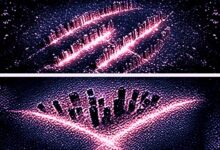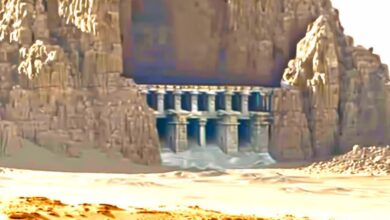Michio Kaku WARNS: “The Moon Is NOT What You Think”

Something about Michio Kaku’s expression was different. This wasn’t the confident, ever-curious physicist we’ve seen countless times on TV unraveling the mysteries of the universe. No—this time he hesitated. His voice cracked. His eyes lingered too long on a single image behind him. And when he finally spoke, the room—filled with scientists, journalists, and historians—fell into complete silence.
This presentation was supposed to be routine: an update on data from lunar observation satellites. Instead, it became a revelation that shook the very foundation of science. This wasn’t just new data. It was a confession—one that could rewrite everything we thought we knew about the Moon. And by the end of his presentation, it was clear why Michio Kaku could no longer hold back tears.
Because what they found beneath the Moon wasn’t natural.
Hollow Chambers Beneath the Surface
Using quantum deep-imaging satellites, researchers scanned the Moon’s subsurface at an unprecedented level of precision. What they discovered stunned the scientific community: enormous hollow cavities—some stretching hundreds of kilometers—arranged in symmetrical patterns no geological process could explain. These were not lava tubes or random voids. They had structure, alignment… intent.
Thermal readings revealed heat signatures emanating from within these chambers—too focused, too deliberate to be natural. Kaku didn’t need to speculate aloud. The data spoke for itself: something beneath the Moon might still be active. Whether it was a reactor, a machine, or something else entirely, no one in that room could dismiss the implications.
The Lunar Grid
Next came the gravitational anomalies. For decades, these small inconsistencies had been dismissed as minor errors. But when mapped in high definition, they formed a precise global lattice—a geometric grid connecting the Moon’s poles and intersecting exactly where the hollow cavities and metallic regions were found.
This was not chaos. This was engineering.
If this grid still functions, it could mean that the Moon is not merely orbiting Earth—it’s regulating it. Our tides, our axis stability, maybe even more. As Kaku put it: “If the Moon was placed, then we must ask—by whom, and for what purpose?”
Ancient Myths Reconsidered
From there, Kaku drew connections to ancient texts. Sumerian, Mayan, and Egyptian records spoke of a time before the Moon—a “new arrival” that altered life on Earth. Stories of sky gods descending from it. Legends that once sounded like poetic allegory now seemed eerily like fragmented memory.
Even eclipses came under scrutiny. The Moon’s size and distance align perfectly to cover the Sun in totality—a phenomenon unique in our solar system. Coincidence? Or deliberate cosmic design?
Metallic Echoes and the “Bell”
The most chilling evidence came from Apollo 12. When NASA crashed a lunar module into the Moon to study seismic activity, it “rang like a bell” for nearly an hour. For decades, this was treated as an oddity. But with the discovery of reflective metals beneath the lunar crust—metals unknown to science—the implications became unavoidable.
Natural rock doesn’t resonate that way unless it’s hollow—or hollow and reinforced. AI-driven simulations now suggest the Moon may not be a planetary body at all, but an engineered object. Later Apollo missions produced the same bell-like echoes. The Moon was behaving like an instrument. Which raised the most unsettling question of all: who built it, and why?
Signals from the Dark Side
Kaku then unveiled another disturbing discovery: low-frequency radio bursts emanating from the Moon’s far side. These signals, detected by radio astronomers, are highly localized and repeat at precise intervals. Filtered through advanced algorithms, some pulses displayed patterns that eerily resembled digital code.
Could it be a beacon? A dormant surveillance system? Or something else… listening?
Even more unsettling, these signals spike whenever deep-space probes pass behind the Moon—almost as if they are being “noticed.”
An Impossible Orbit
Then there is the Moon’s orbit itself: a perfect configuration that allows it to stabilize Earth’s rotation and create total eclipses. It is also tidally locked, showing us only one face forever. Textbooks call this coincidence. Kaku no longer could.
The Moon’s improbable precision makes it seem less like a satellite—and more like a mechanism.
The Erased Evidence
But the most disturbing part wasn’t data—it was what’s missing. Kaku revealed that many Apollo mission recordings—telemetry, high-frequency transmissions, even astronaut logs—have mysteriously vanished or been recorded over. Whistleblowers claim these tapes once contained references to unexplained lights, mechanical sounds beneath the surface, and sudden communication blackouts on the Moon’s far side.
For decades, NASA’s silence has been deafening.
A Final Warning
As Kaku stepped back from the podium, no one in that room spoke. This was not awe. It was fear.
The Moon—once a romantic symbol of light and calm—suddenly felt like something else entirely. Perhaps it isn’t natural. Perhaps it isn’t lifeless. Perhaps it isn’t even ours.
From its impossible orbit to its hollow echoes, from vanishing Apollo data to ancient myths that now feel like warnings, one conclusion became unavoidable: the Moon might be a construct. And if it is, then something placed it there.
And if Michio Kaku—one of the most rational scientific minds alive—was brought to tears by this knowledge… maybe we should all be paying attention.
Because this isn’t just about astronomy anymore.
This is about what’s been watching us from above—since the beginning.







